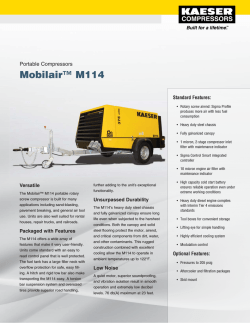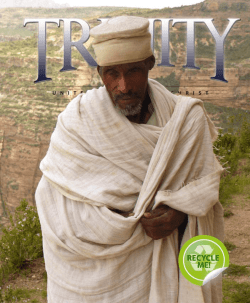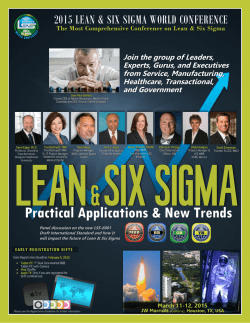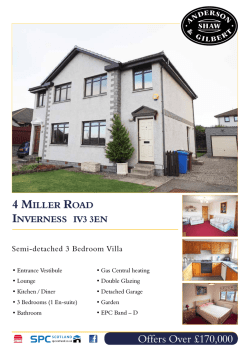
Credit Course Introduction
Introduction to the world of Managing Credit Risk under Basel 1 © 2014 Copyright 6 Sigma Group. All rights reserved. Reproduction without written permission is strictly prohibited Important Notice © 2014 Copyright 6 Sigma Group (6 Sigma). All rights reserved. This documents and all the concepts, drawings, designs and other elements contained within it are proprietary to and all intellectual property and other rights in or in respect of the same are owned by 6 Sigma. You may not, whether in whole or in part, use, copy, duplicate, reproduce, adapt or otherwise incorporate into Please Note other formats, media or derivative works of any kind any or all parts of this document, its contents, concepts, drawings, designs and other elements contained within it without the prior written consent of 6 Sigma. 6 Sigma™ is a trade mark of 6 Sigma Group and similarly may not be used without 6 Sigma's permission. 2 © 2014 Copyright 6 Sigma Group. All rights reserved. Reproduction without written permission is strictly prohibited Basel’s Findings 3 © 2014 Copyright 6 Sigma Group. All rights reserved. Reproduction without written permission is strictly prohibited Basel Accords - Findings 1. Some banks are not very good with carrying out thorough credit assessments or basic due diligence. These include: 1. Approving credits based on simple indicators. Also new information may not be available, specially that used in assessing new counterparties (institutional investors or highly leveraged entities). 2. Lack of testing and validation of new lending techniques without the benefit of sound principles and due diligence (eg use of credit scoring models in the US which led to large losses). 3. Subjective decision making by senior management. 4. Lack of an effective credit review process. Has to be independent from the economic beneficiary of the credit. Credit review has to have the checks and balances to ensure it abides by bank policies, provides judgment on quality, and strengthens accountability. 4 Credit Process Issues © 2014 Copyright 6 Sigma Group. All rights reserved. Reproduction without written permission is strictly prohibited Basel Accords - Findings contd 5. Failure to monitor borrower or collateral values. Lack of periodic financials or appraisals; hence lack of recognition of early warning signs. 6. Inability to detect credit-related fraud, due to lack of checking financials, credit, and collateral. 7. Lack of risk-sensitive pricing, and hence lack of counterbalance to risks. 8. Lack of validation of correlation between borrower and underlying asset values (leasing, asset based financing, real estate). Concentration of income from the assets. 9. Lack of accounting of business cycle effects. Hence the use of optimistic assumptions (cyclical industries include retailing, real estate, utilities, consumer lending), where it is linked to the product cycle (rapidly growing etc). Need to stress-test. 10. Lack of consideration of a downside scenario. Vulnerability to specific factors (commodities, competition, etc). Again stress tests are needed. 5 Credit Process Issues © 2014 Copyright 6 Sigma Group. All rights reserved. Reproduction without written permission is strictly prohibited How Risk is defined 6 © 2014 Copyright 6 Sigma Group. All rights reserved. Reproduction without written permission is strictly prohibited Risk and Capital Capital Adequacy = Risk Capital 10.5% Credit Risk + Market Risk + Operational Risk Risk 177 Criteria: Financial + Mgt + Industry + Environment Credit Risk Historical + Projected + Sensitivity These Determine Expected Loss (EL) and Unexpected Loss (UL), and Capital (EL+UL) 7 Financial PD x LGD © 2014 Copyright 6 Sigma Group. All rights reserved. Reproduction without written permission is strictly prohibited EL and UL – Probability Density Function of Losses (PDF) Total Capital Charge under IRB Expected Losses Unexpected Losses (Economic Capital) Frequency of default A Credit Risk Model encompasses all of the policies, procedures, and practices used by a bank in estimating a credit portfolio’s PDF. Mean (EL) 8 99% conf LGD © 2014 Copyright 6 Sigma Group. All rights reserved. Reproduction without written permission is strictly prohibited Essentially Credit Risk is …….. ∑ each Facility EAR x PD x LGD PRR Total EAR Facility Type and Amount (Xsell, R/E, RORAC) TM (Risk Rating) & RACs (CPPs, SOW) Bank needs to manage all these at all times Collateral, RR Management & Problem Recognition 9 © 2014 Copyright 6 Sigma Group. All rights reserved. Reproduction without written permission is strictly prohibited Degrees of Sophistication 10 © 2014 Copyright 6 Sigma Group. All rights reserved. Reproduction without written permission is strictly prohibited So How Does Basel Do It? Capital Adequacy = EAR x 10.5% : eq. PRR of 6+ Standardized Capital Adequacy = EAR x PD x 45% IRB F Capital Adequacy = EAR x PD x LGD IRB A # of Defaulters / Total # Obligors per Risk Rating PDs assessed 1. Definition of Default: 7 days, 30 days, 60 days or 90 days + 2. Risk Rating: Has to be as granular as possible to remain consistent Challenges 177 Criteria: Financial + Mgt + Industry + Environment Risk Rating Historical + Projected + Sensitivity 11 Financial © 2014 Copyright 6 Sigma Group. All rights reserved. Reproduction without written permission is strictly prohibited Example of Risk Weighting under Standardized Co A Facility No 1 2 3 4 Type OD OD FX FX Limit 2,178 250 2,550 500 Loan Eq. 100% 100% 50% 50% Risk Adj. 2,178 250 1,275 250 B 1 2 3 OD LCR LG 817 2,000 1,089 100% 100% 50% 817 2,000 545 C 1 2 LC LG 1,361 2,450 20% 50% 272 1,225 D 1 2 3 OD LC LG 2,178 100 2,178 100% 20% 50% 2,178 20 1,089 E 1 2 TL FX 1651 550 100% 50% 1,651 275 Total 19,852 Capital 12 1.Assume a 100% RW clients. 2.CCFed total = 14,025 3.Total Capital required: 8%x100%x14,025 = 1,122 14,025 8% 1122 © 2014 Copyright 6 Sigma Group. All rights reserved. Reproduction without written permission is strictly prohibited Simple Example of Reduced Capital Allocation under IRB Fac ilit y Weight ed RR (bpt s ) A v erage Co No Ty pe Limit A 1 OD 2,178 100% 2,178 AA 0 0 2 OD 250 100% 250 AA 0 0 3 FX 2,550 50% 1,275 AA 0 0 4 FX 500 50% 250 AA 0 0 1 OD 817 100% 817 A 0.4 327 2 LCR 2,000 100% 2,000 A 0.4 800 3 LG 1,089 50% 545 A 0.4 218 1 LC 1,361 20% 272 Baa 7 1,905 2 LG 2,450 50% 1,225 Baa 7 8,575 1 OD 2,178 100% 2,178 Ba 56 121,968 2 LC 100 20% 20 Ba 56 1,120 3 LG 2,178 50% 1,089 Ba 56 60,984 1 TL 1651 100% 1,651 B 291 480,441 2 FX 550 50% 275 B 291 80,025 Tot al 19, 852 54 756, 363 B C D E 13 Loan E q. Ris k A dj. Los s Norms 14, 025 Capital 8% 1,122 Basel III 10.5% 1,473 EL = EL+UL = 76 150 Exposure Converted into Loan Equivalent Amounts Total Reserves calculated using Loss Norms (in IRB Advanced approach) Standardized Cap.= 1,473 IRB Capital = 150 © 2014 Copyright 6 Sigma Group. All rights reserved. Reproduction without written permission is strictly prohibited Banking Business Model (RAROC) Revenues (net of funding costs) ie Marketing / Selling Business Margin less Expenses (Wages, Rent, etc) from Rev/Exp ratio less Cost of Credit (Specific Provisions + EL) Loss Norm = EAR*PD*LGD Net Profits before Taxes and Other Reserves NP = Economic Capital (UL) x ROEC Based on the adopted Risk Rating System and verified by empirical evidence for measuring PD and LGD 14 EL and UL © 2014 Copyright 6 Sigma Group. All rights reserved. Reproduction without written permission is strictly prohibited Application 15 © 2014 Copyright 6 Sigma Group. All rights reserved. Reproduction without written permission is strictly prohibited Issues Relating to Cost of Credit Is dependent on various factors including financials, management, industry, environment etc Its value is verified using empirical evidence Should be controlled and managed over time Process to be managed to ensure maximum recoveries Can be reduced using specific methodologies Also influenced by seniority of exposure and collateral Effectiveness of control is assessed using empirical evidence Help balance risk with rewards. Covers Credit, Operational and Market Risks Involve: Basel II (following Basel I) Standardized Approach IRB Foundation & Advanced Approaches 16 © 2014 Copyright 6 Sigma Group. All rights reserved. Reproduction without written permission is strictly prohibited PD LGD Basel Accords Common Reasons for Corporate Failures Too much debt Inadequate leadership Poor planning Failure to change Inexperienced management Not enough revenue Other (source ibisassoc.co.uk) 28% 17% 14% 11% 9% 8% 13% 100% Total Management 51% Inexperience includes: 1.too much credit to clients Dunn and Bradstreet rates it higher at 87% covering: • Incompetence 46% • Lack of Management Experience 30% • Lack of Product and Service Experience 11% 17 2.inadequate inventory levels 3.inadequate borrowing practices © 2014 Copyright 6 Sigma Group. All rights reserved. Reproduction without written permission is strictly prohibited Pillars of a Risk Rating System 50% 30% Management Financial Strength Character, Depth, MIS Risk Mgt, Experience Story, Projections, Sensitivity degree of 1-10 1-10 riskiness 1. Used to show 2. Includes both 1 10% 18 10 Risk Rating financial and non 10% Industry Environment Trends, Market Share, Technology, Talent Economy, Politics, Contagion, Trends 1-10 1-10 financial elements – each rated on a scale of 1 to 10 (1 lowest risk) © 2014 Copyright 6 Sigma Group. All rights reserved. Reproduction without written permission is strictly prohibited How to Reduce Probability of Default Identify and Stick to a Target Market and Risk Acceptance Criteria (TM & RACs) Chose Your Clients Carefully Use appropriate analytical techniques to assess financials, identify associated risks, and measure them Assess Financial Performance Assess Management, and other non-financial risks Assess nonFinancial Attributes Amount, Duration, Covenants, Collateral Does the client need it, can it repay on time etc… Structure Facilities Appropriately 19 © 2014 Copyright 6 Sigma Group. All rights reserved. Reproduction without written permission is strictly prohibited How to Reduce Loss Given Default Hire effective and experienced relationship managers Quality Credit Hierarchy Understand and React to Early Warning Signals Early Problem Recognition Manage Internal Information and Approval Processes Efficiently Classification System & Control Manage Negotiations Effectively Increase Collateral Tighten Structuring Effective Negotiation Skills 20 © 2014 Copyright 6 Sigma Group. All rights reserved. Reproduction without written permission is strictly prohibited Why Improve the PRR and How? Exposure 312 Exposure 1,250 Exposure 2,500 1% 4% 8% for Capital = 100 ROC By: 1. Type of Client 2. Number of Clients 3. Type of Facility 4. Amount of Facility 5. Collateral Security 7 12% 400% increase in capital 21 6 3% 5 1.5% 6. Early Problem Recognition 50% saving © 2014 Copyright 6 Sigma Group. All rights reserved. Reproduction without written permission is strictly prohibited The Training: Financial Analysis 22 © 2014 Copyright 6 Sigma Group. All rights reserved. Reproduction without written permission is strictly prohibited How to Analyze Financials? 1. Can Obligor generate Cash? 2. Is CF Enough? Business Model EBITDA % 3. What is obligor behavior? DSCR Interest Withdrawals DSCR Short Term Investments NOCF + or - DSCR Total Debt Related Parties Sales Growth COGS % SG&A % Receivable Aging Inventory Aging Payable Aging Future IS, BS, CF NOCF DSCRs CC % + = Impact on future NOCF and DSCRs from deviations to projections 23 Historical Future Sensitivity © 2014 Copyright 6 Sigma Group. All rights reserved. Reproduction without written permission is strictly prohibited The Consultancy 24 © 2014 Copyright 6 Sigma Group. All rights reserved. Reproduction without written permission is strictly prohibited Basel’s Principle for Managing Credit Risk 1. The bank should conduct itself along a set of Principals which are subject to Board Approval. These Principals are derived from a variety of experiences, rules and regulations and recommendations from various entities, and are in line with Basel II guidelines. 2. The objective of these Principals is to allow the bank to identify, measure and control credit risk, and in the process determine the amount of Capital needed against it. As such, the bank’s processes and procedures should allow its personnel to: 3. Establish appropriate credit environments; Operate under a sound credit-granting process; Maintain an appropriate credit administration; and Ensure adequate controls over credit risk. The Principals are divided into 2 groups covering 18 specific guidelines as follows: 25 Processes and Procedures Risk Management © 2014 Copyright 6 Sigma Group. All rights reserved. Reproduction without written permission is strictly prohibited Processes and Procedures 1. Governance – Board of Directors 2. Governance – Senior Management 3. Management Role 4. Credit Granting Criteria 5. Establishing Limits 6. Well Defined Process and Procedures 7. Objective and Arm’s Length Assessments 8. Credit Administration 9. Monitoring Credits 26 © 2014 Copyright 6 Sigma Group. All rights reserved. Reproduction without written permission is strictly prohibited Coverage Risk Management 10. Utilizing a Risk Rating System 11. Use of MIS 12. Portfolio Management 13. Stress Testing 14. Reporting and Feedback 15. Prudential Supervision 16. Early Problem Recognition and Remedial Management 17. MIS & Compliance 18. Capital Adequacy Calculation (extra) 19. Responsibilities (extra) 27 © 2014 Copyright 6 Sigma Group. All rights reserved. Reproduction without written permission is strictly prohibited Coverage The Risk Rating Platform 28 © 2014 Copyright 6 Sigma Group. All rights reserved. Reproduction without written permission is strictly prohibited
© Copyright 2025







